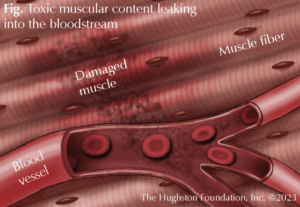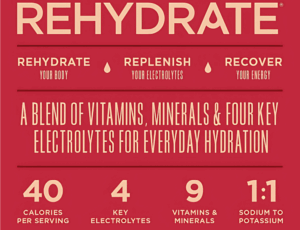You’ve crushed a brutal training session. You’re sore – sore enough that stairs feel like a punishment. But what if that soreness isn’t just a badge of honor? What if it’s a warning sign? That’s the slippery slope where rhabdomyolysis, or rhabdo, lives.
Most athletes think of rhabdo as something that happens to “other people” – the ones who go way too hard, way too fast. But the truth is, rhabdo doesn’t care if you’re elite or just enthusiastic. It shows up when your body crosses the line between pushing limits and systemic breakdown.
Let’s unpack what rhabdo is, how it happens, who’s at risk, and how to make sure your grind doesn’t land you in the ER.
What Is Rhabdomyolysis?
Rhabdomyolysis is a condition where skeletal muscle tissue breaks down so severely that its contents, especially the protein myoglobin, leak into the bloodstream. When too much myoglobin floods your system, it can clog your kidneys, trigger dangerous electrolyte imbalances, and in severe cases, cause acute kidney failure.
so severely that its contents, especially the protein myoglobin, leak into the bloodstream. When too much myoglobin floods your system, it can clog your kidneys, trigger dangerous electrolyte imbalances, and in severe cases, cause acute kidney failure.
In other words, your muscles literally poison your blood when they’re pushed past their limits.
While rhabdo can be caused by trauma (like crush injuries or car accidents), exercise-induced rhabdomyolysis is what athletes need to worry about. It’s most often triggered by:
- Excessive eccentric loading (e.g., too many negatives, GHD sit-ups)
- High-volume training after time off
- Intense heat or dehydration
- Stacking stimulants or performance enhancers
How Rhabdo Happens in Sports
Muscles naturally break down during hard training – that’s part of the process. But rhabdo occurs when:
- Muscle breakdown outpaces the body’s repair mechanisms
- Damaged muscle cells rupture, releasing toxins like creatine kinase and myoglobin
- The kidneys can’t clear the overload, leading to potentially life-threatening complications
This can happen after a single insane workout, especially if the athlete is unaccustomed to that kind of stress. That’s why rhabdo often hits:
- Newbies in CrossFit or HIIT trying to keep up with the pack
- Wrestlers, grapplers, or MMA fighters cutting weight in extreme heat
- Marathoners or triathletes pushing through pain late in a race
- Military trainees or fitness competitors returning after injury or layoff
And it’s not just physical stress. Heat, dehydration, and stimulants (like pre-workouts or energy drinks) can dramatically amplify risk.
Symptoms: When Soreness Becomes Dangerous
Soreness is normal. But if you experience the following, get checked out immediately:
Classic Signs of Rhabdo:
- Extreme muscle pain or swelling that worsens over time

- Dark, tea-colored urine
- Reduced or no urination
- Severe fatigue or weakness
- Nausea, vomiting, or confusion
This isn’t just DOMS (delayed onset muscle soreness). If your limbs feel tight like sausages, if you can’t move without searing pain, or if your pee looks like cola, you need medical attention – fast.
Common Rhabdo Examples
Rhabdo isn’t actually all that rare – it’s just underreported, especially in competitive subcultures where toughness is worn like armor.
Case Study: The Jiu-Jitsu Grappler
A regional BJJ competitor attempted an intense circuit of GHD sit-ups, sled pushes, and wall balls after three weeks off due to illness. By day two, he couldn’t straighten his arms. His forearms swelled, and his urine turned brown. He ended up in the ER with full-blown rhabdo and missed the biggest tournament of his season.
Case Study: The Ultra-Endurance Rookie
A first-time ultramarathoner pushed through 60 miles of mountainous terrain in high heat. She downplayed her nausea and tight calves, thinking it was par for the course. When she collapsed at the finish, tests revealed acute kidney damage due to rhabdo. It took months to recover.
terrain in high heat. She downplayed her nausea and tight calves, thinking it was par for the course. When she collapsed at the finish, tests revealed acute kidney damage due to rhabdo. It took months to recover.
CrossFit and Rhabdo
CrossFit has a complicated history with rhabdo, even coining the dark-humored mascot “Uncle Rhabdo.” While the sport has matured (somewhat) in programming safety, the culture of “never quit” intensity still leads to preventable cases, especially in beginners.
Supplements That Contribute
Most people don’t realize how certain supplements and medications can increase susceptibility:
- Creatine doesn’t cause rhabdo directly, but if taken in large amounts with insufficient hydration, it could increase stress on kidneys.
- Stimulants (e.g., caffeine, synephrine, DMAA) can increase body temp and reduce blood flow to muscles.
- Statins and certain antibiotics have rhabdo as a rare side effect.
The takeaway? Be intentional with what you put in your body – especially under heavy load.
How to Prevent Rhabdo Without Babying Your Training
This isn’t a call to go soft – it’s a reminder that smart training is sustainable training.
Tips to Stay Safe While Staying Savage:
- Progress gradually: Ramp up volume over weeks, not overnight.

- Respect the eccentric: Especially with movements like GHD sit-ups or heavy negatives.
- Hydrate like it’s your job: Not just water – include electrolytes, especially in heat.
- Cycle your intensity: Periodization prevents overreaching and allows for full recovery.
- Know your return window: Coming back from time off? Ease in. Muscle memory isn’t the same as cellular resilience.
- Listen to your body: Pain ≠ weakness. Sometimes, it’s a red flag.
Pro Tip:
Train with people who watch your form, not just your numbers.
A good training environment emphasizes health and longevity over ego and Instagram-able PRs.
Why Rhabdo Deserves More Attention
Beyond the risk of hospitalization, rhabdo can leave lasting damage:
- Scarring of kidney tissue
- Electrolyte imbalances
- Chronic muscle weakness
- Psychological trauma from injury and distress from time off
Worse, many cases go undiagnosed, chalked up to “a bad week of soreness.” Ignoring it doesn’t make it rare – it just makes it more dangerous.
In a performance culture that glorifies grind, we need more nuance. Strength isn’t just physical – it’s strategic. And resilience isn’t forged by pushing past every limit. It’s forged by knowing when to hold back and when to go hard.
Conclusion: Earn Your Intensity
Rhabdomyolysis isn’t just a CrossFit cautionary tale. It’s a real risk for anyone who trains hard without enough awareness, recovery, or hydration. The good news? It’s almost always preventable with education, programming discipline, and respect for your body’s limits.
Train hard. Train often. But train smart. The goal isn’t just to survive your workouts – it’s to thrive because of them.










